Critical Reflection on Leading Practice: Leadership Example Analysis
VerifiedAdded on 2022/09/18
|10
|3296
|29
Report
AI Summary
This report presents a critical reflection on leading practices within an educational setting, focusing on the role of the vice-principal in a secondary school. The student analyzes the implementation of educational and transformational leadership to improve school performance, teacher development, and student learning. The report details the context of the leadership, the purpose of the changes, and the effects of implementing various leadership mechanisms. It discusses the importance of educational leadership in creating a collaborative environment between teachers, students, and parents. Transformational leadership was also implemented to develop the competencies of teachers and staffs. The report evaluates the successes and failures of the leadership approaches, including the importance of communication, feedback, and integration of parents. The student also suggests improvements, such as enhancing parent-teacher forums and feedback processes. The analysis identifies key stakeholders and sites of contestation, emphasizing the need for a holistic approach to leadership development that encompasses internal and external factors to foster overall improvement. This assignment provides an insightful perspective on leadership in education, offering practical recommendations for future practice.
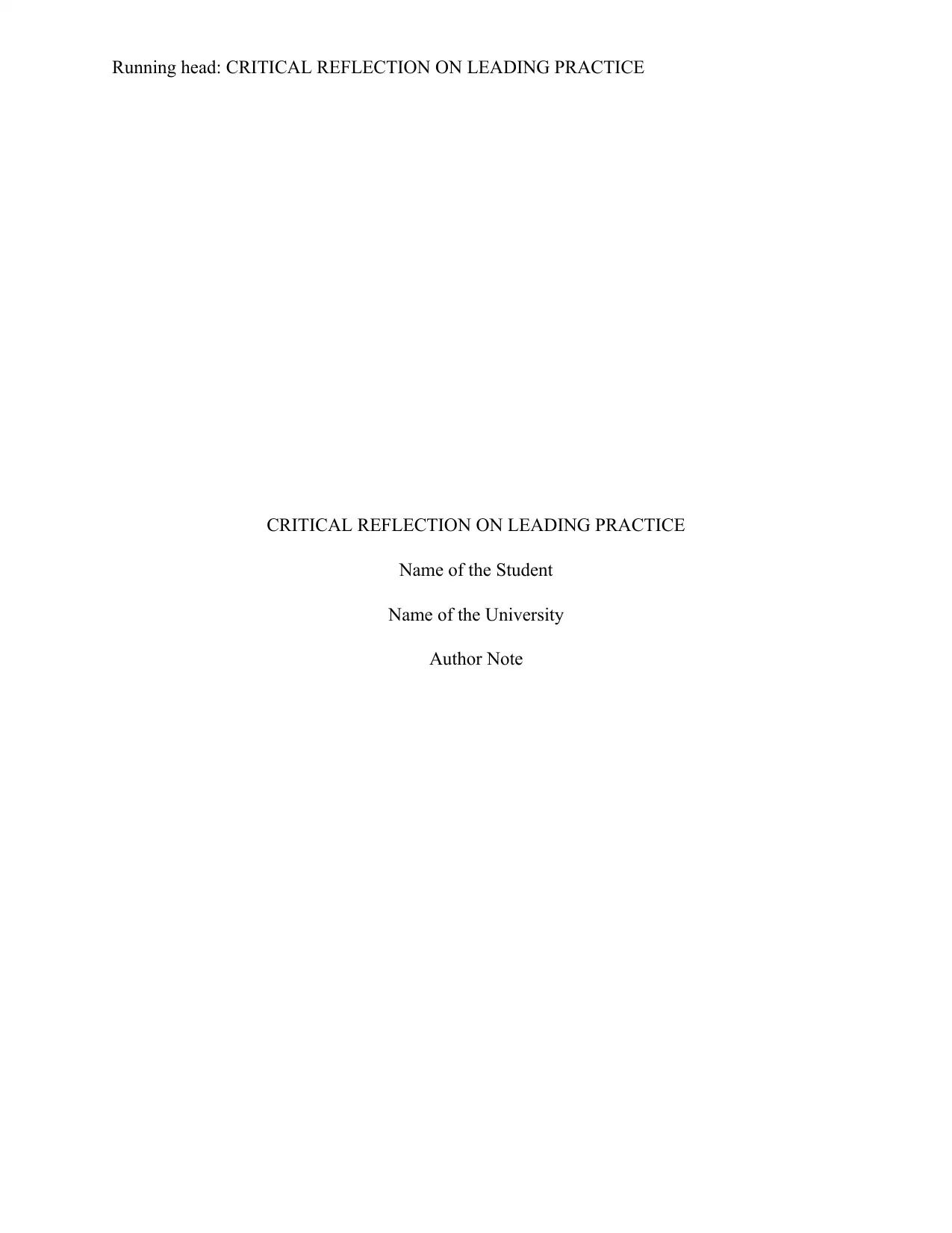
Running head: CRITICAL REFLECTION ON LEADING PRACTICE
CRITICAL REFLECTION ON LEADING PRACTICE
Name of the Student
Name of the University
Author Note
CRITICAL REFLECTION ON LEADING PRACTICE
Name of the Student
Name of the University
Author Note
Paraphrase This Document
Need a fresh take? Get an instant paraphrase of this document with our AI Paraphraser

1CRITICAL REFLECTION ON LEADING PRACTICE
Context
The leadership context that is being focused is educational leadership setting. As a leader
I was focused towards bringing about change. The setting was important as the leadership
effectiveness that I could develop in the setting was to be tested. As a leader the main purpose I
had in the setting was to create better results in terms of operational performance of the school.
The setting that was selected was that of a secondary school with significant need for
performance improvement and development of more engaging curriculum. My aim as the leader
was to bring about changes that could positively impact the educational practices and student
learning in the institution. The unique part of my work was to find out the most important
leadership mechanisms that could help the all-round improvement of the school. The leadership
mechanisms of the schools are generally very rigid. This was also the case with the school that
was considered. However, this was not effective enough to improve the overall performance of
the school. The educational practices and the student learning improvement aspects were the
main focus for the developmental change that was intended. Some of the more general context of
the leadership was to make sure of the productive outcomes that could be achieved. This was a
very important leadership experience for me as this was one of the large scale leadership roles
that I was going to manage. I was the vice-principal of the school and my role was to implement
newer policies and functional areas that could improve the performances and holistic
development of the teachers, staffs and students.
Purpose
The purpose was to bring about positive changes in the management functions of the
organization. Schools have generally rigid leadership systems that are often developed in
accordance of mechanistic organizational design. This means that the decision making functions
are done by only the head management of the schools. The intended change that was focused to
be achieved was to develop a better leadership approach that would not only be beneficial for the
students but also facilitate the professional development of the teachers and the staffs. The
organizational setup and the management style was to be change. The focus was hence towards
finding the best possible solutions that I can provide for the management issues. In order to do
the same I needed to cooperate and coordinate effectively with the principal and the higher
management of the school. The intended change was to improve the effectiveness of the
Context
The leadership context that is being focused is educational leadership setting. As a leader
I was focused towards bringing about change. The setting was important as the leadership
effectiveness that I could develop in the setting was to be tested. As a leader the main purpose I
had in the setting was to create better results in terms of operational performance of the school.
The setting that was selected was that of a secondary school with significant need for
performance improvement and development of more engaging curriculum. My aim as the leader
was to bring about changes that could positively impact the educational practices and student
learning in the institution. The unique part of my work was to find out the most important
leadership mechanisms that could help the all-round improvement of the school. The leadership
mechanisms of the schools are generally very rigid. This was also the case with the school that
was considered. However, this was not effective enough to improve the overall performance of
the school. The educational practices and the student learning improvement aspects were the
main focus for the developmental change that was intended. Some of the more general context of
the leadership was to make sure of the productive outcomes that could be achieved. This was a
very important leadership experience for me as this was one of the large scale leadership roles
that I was going to manage. I was the vice-principal of the school and my role was to implement
newer policies and functional areas that could improve the performances and holistic
development of the teachers, staffs and students.
Purpose
The purpose was to bring about positive changes in the management functions of the
organization. Schools have generally rigid leadership systems that are often developed in
accordance of mechanistic organizational design. This means that the decision making functions
are done by only the head management of the schools. The intended change that was focused to
be achieved was to develop a better leadership approach that would not only be beneficial for the
students but also facilitate the professional development of the teachers and the staffs. The
organizational setup and the management style was to be change. The focus was hence towards
finding the best possible solutions that I can provide for the management issues. In order to do
the same I needed to cooperate and coordinate effectively with the principal and the higher
management of the school. The intended change was to improve the effectiveness of the
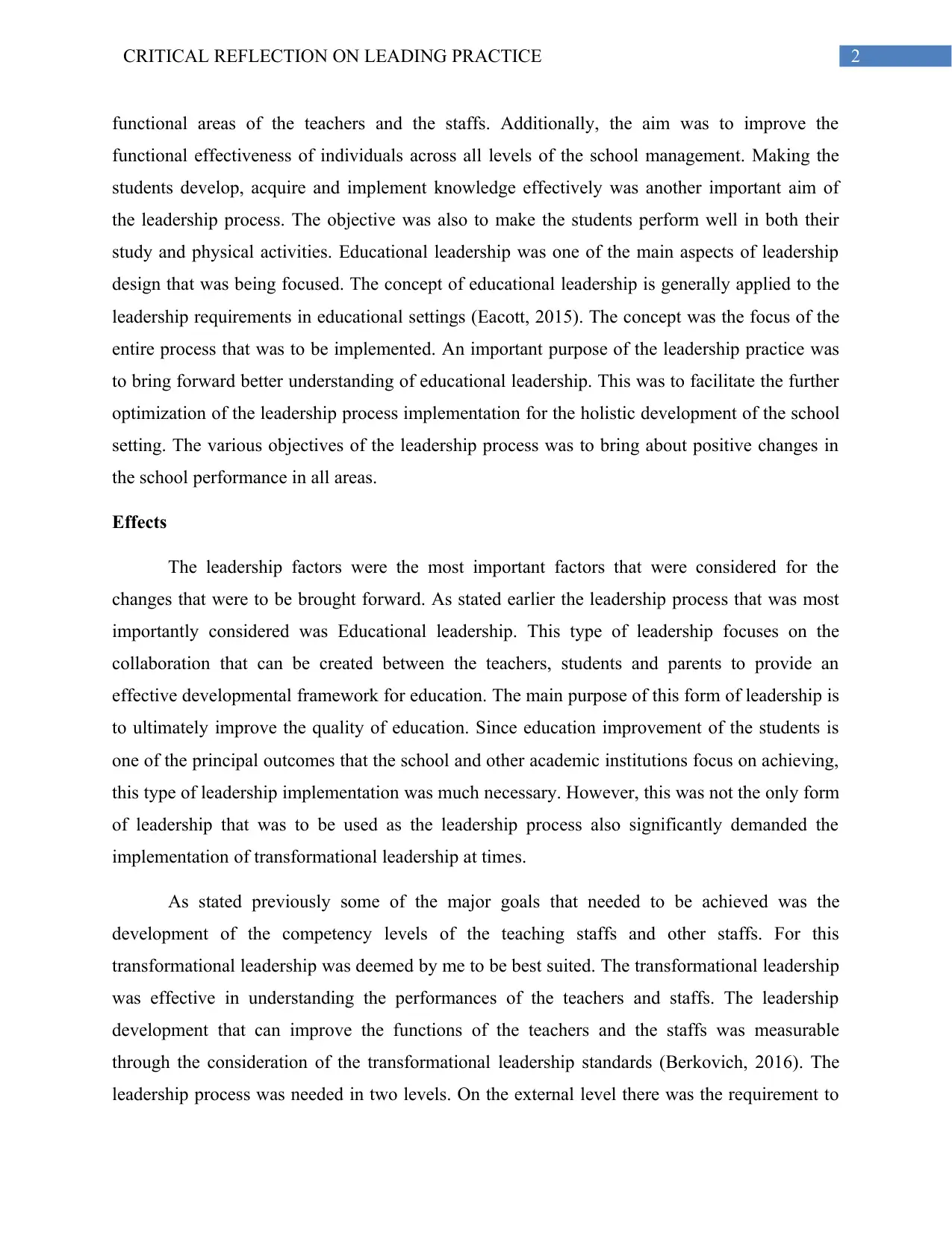
2CRITICAL REFLECTION ON LEADING PRACTICE
functional areas of the teachers and the staffs. Additionally, the aim was to improve the
functional effectiveness of individuals across all levels of the school management. Making the
students develop, acquire and implement knowledge effectively was another important aim of
the leadership process. The objective was also to make the students perform well in both their
study and physical activities. Educational leadership was one of the main aspects of leadership
design that was being focused. The concept of educational leadership is generally applied to the
leadership requirements in educational settings (Eacott, 2015). The concept was the focus of the
entire process that was to be implemented. An important purpose of the leadership practice was
to bring forward better understanding of educational leadership. This was to facilitate the further
optimization of the leadership process implementation for the holistic development of the school
setting. The various objectives of the leadership process was to bring about positive changes in
the school performance in all areas.
Effects
The leadership factors were the most important factors that were considered for the
changes that were to be brought forward. As stated earlier the leadership process that was most
importantly considered was Educational leadership. This type of leadership focuses on the
collaboration that can be created between the teachers, students and parents to provide an
effective developmental framework for education. The main purpose of this form of leadership is
to ultimately improve the quality of education. Since education improvement of the students is
one of the principal outcomes that the school and other academic institutions focus on achieving,
this type of leadership implementation was much necessary. However, this was not the only form
of leadership that was to be used as the leadership process also significantly demanded the
implementation of transformational leadership at times.
As stated previously some of the major goals that needed to be achieved was the
development of the competency levels of the teaching staffs and other staffs. For this
transformational leadership was deemed by me to be best suited. The transformational leadership
was effective in understanding the performances of the teachers and staffs. The leadership
development that can improve the functions of the teachers and the staffs was measurable
through the consideration of the transformational leadership standards (Berkovich, 2016). The
leadership process was needed in two levels. On the external level there was the requirement to
functional areas of the teachers and the staffs. Additionally, the aim was to improve the
functional effectiveness of individuals across all levels of the school management. Making the
students develop, acquire and implement knowledge effectively was another important aim of
the leadership process. The objective was also to make the students perform well in both their
study and physical activities. Educational leadership was one of the main aspects of leadership
design that was being focused. The concept of educational leadership is generally applied to the
leadership requirements in educational settings (Eacott, 2015). The concept was the focus of the
entire process that was to be implemented. An important purpose of the leadership practice was
to bring forward better understanding of educational leadership. This was to facilitate the further
optimization of the leadership process implementation for the holistic development of the school
setting. The various objectives of the leadership process was to bring about positive changes in
the school performance in all areas.
Effects
The leadership factors were the most important factors that were considered for the
changes that were to be brought forward. As stated earlier the leadership process that was most
importantly considered was Educational leadership. This type of leadership focuses on the
collaboration that can be created between the teachers, students and parents to provide an
effective developmental framework for education. The main purpose of this form of leadership is
to ultimately improve the quality of education. Since education improvement of the students is
one of the principal outcomes that the school and other academic institutions focus on achieving,
this type of leadership implementation was much necessary. However, this was not the only form
of leadership that was to be used as the leadership process also significantly demanded the
implementation of transformational leadership at times.
As stated previously some of the major goals that needed to be achieved was the
development of the competency levels of the teaching staffs and other staffs. For this
transformational leadership was deemed by me to be best suited. The transformational leadership
was effective in understanding the performances of the teachers and staffs. The leadership
development that can improve the functions of the teachers and the staffs was measurable
through the consideration of the transformational leadership standards (Berkovich, 2016). The
leadership process was needed in two levels. On the external level there was the requirement to
⊘ This is a preview!⊘
Do you want full access?
Subscribe today to unlock all pages.

Trusted by 1+ million students worldwide
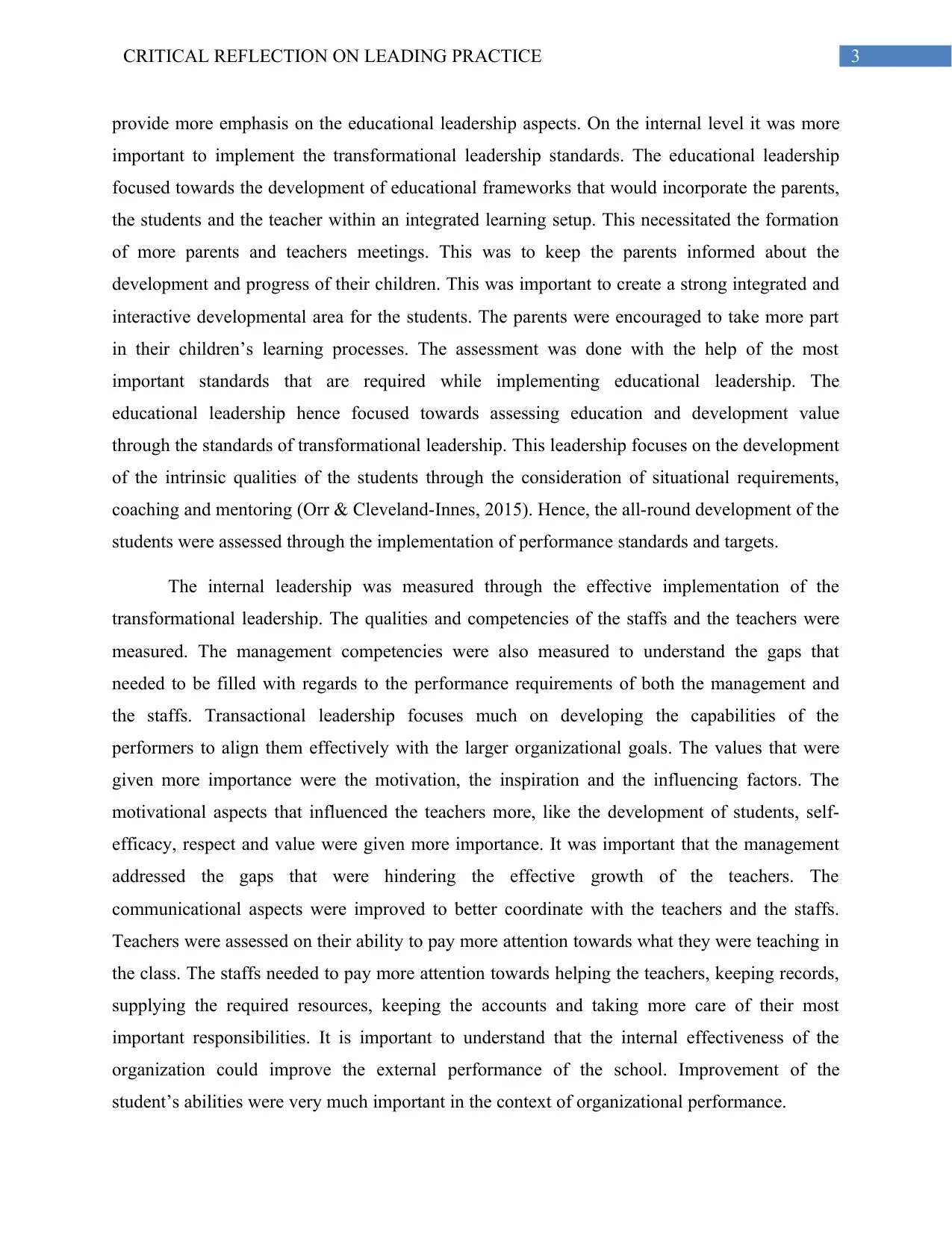
3CRITICAL REFLECTION ON LEADING PRACTICE
provide more emphasis on the educational leadership aspects. On the internal level it was more
important to implement the transformational leadership standards. The educational leadership
focused towards the development of educational frameworks that would incorporate the parents,
the students and the teacher within an integrated learning setup. This necessitated the formation
of more parents and teachers meetings. This was to keep the parents informed about the
development and progress of their children. This was important to create a strong integrated and
interactive developmental area for the students. The parents were encouraged to take more part
in their children’s learning processes. The assessment was done with the help of the most
important standards that are required while implementing educational leadership. The
educational leadership hence focused towards assessing education and development value
through the standards of transformational leadership. This leadership focuses on the development
of the intrinsic qualities of the students through the consideration of situational requirements,
coaching and mentoring (Orr & Cleveland-Innes, 2015). Hence, the all-round development of the
students were assessed through the implementation of performance standards and targets.
The internal leadership was measured through the effective implementation of the
transformational leadership. The qualities and competencies of the staffs and the teachers were
measured. The management competencies were also measured to understand the gaps that
needed to be filled with regards to the performance requirements of both the management and
the staffs. Transactional leadership focuses much on developing the capabilities of the
performers to align them effectively with the larger organizational goals. The values that were
given more importance were the motivation, the inspiration and the influencing factors. The
motivational aspects that influenced the teachers more, like the development of students, self-
efficacy, respect and value were given more importance. It was important that the management
addressed the gaps that were hindering the effective growth of the teachers. The
communicational aspects were improved to better coordinate with the teachers and the staffs.
Teachers were assessed on their ability to pay more attention towards what they were teaching in
the class. The staffs needed to pay more attention towards helping the teachers, keeping records,
supplying the required resources, keeping the accounts and taking more care of their most
important responsibilities. It is important to understand that the internal effectiveness of the
organization could improve the external performance of the school. Improvement of the
student’s abilities were very much important in the context of organizational performance.
provide more emphasis on the educational leadership aspects. On the internal level it was more
important to implement the transformational leadership standards. The educational leadership
focused towards the development of educational frameworks that would incorporate the parents,
the students and the teacher within an integrated learning setup. This necessitated the formation
of more parents and teachers meetings. This was to keep the parents informed about the
development and progress of their children. This was important to create a strong integrated and
interactive developmental area for the students. The parents were encouraged to take more part
in their children’s learning processes. The assessment was done with the help of the most
important standards that are required while implementing educational leadership. The
educational leadership hence focused towards assessing education and development value
through the standards of transformational leadership. This leadership focuses on the development
of the intrinsic qualities of the students through the consideration of situational requirements,
coaching and mentoring (Orr & Cleveland-Innes, 2015). Hence, the all-round development of the
students were assessed through the implementation of performance standards and targets.
The internal leadership was measured through the effective implementation of the
transformational leadership. The qualities and competencies of the staffs and the teachers were
measured. The management competencies were also measured to understand the gaps that
needed to be filled with regards to the performance requirements of both the management and
the staffs. Transactional leadership focuses much on developing the capabilities of the
performers to align them effectively with the larger organizational goals. The values that were
given more importance were the motivation, the inspiration and the influencing factors. The
motivational aspects that influenced the teachers more, like the development of students, self-
efficacy, respect and value were given more importance. It was important that the management
addressed the gaps that were hindering the effective growth of the teachers. The
communicational aspects were improved to better coordinate with the teachers and the staffs.
Teachers were assessed on their ability to pay more attention towards what they were teaching in
the class. The staffs needed to pay more attention towards helping the teachers, keeping records,
supplying the required resources, keeping the accounts and taking more care of their most
important responsibilities. It is important to understand that the internal effectiveness of the
organization could improve the external performance of the school. Improvement of the
student’s abilities were very much important in the context of organizational performance.
Paraphrase This Document
Need a fresh take? Get an instant paraphrase of this document with our AI Paraphraser

4CRITICAL REFLECTION ON LEADING PRACTICE
Learnings
The various practices that were important for the development of better teaching
standards were incorporated within the leadership process. It is important to determine the value
of the entire processes that were implemented to facilitate the effective growth of the leadership
standards. The leadership practices that were implemented were educational leadership and
transformational leadership. Various processes were implemented in order to create better
development frameworks and leadership improvement. At the same time the leadership
processes that were most important for the effective growth of the students were focused. It was
important that the leadership orientations were effectively aligned with the developmental
standards that were required for the organization (Amanchukwu, Stanley & Ololube, 2015).
There were various steps that were taken to improve the management of the school.
However, more could have been done to further improve the functional areas of both the internal
and the external management operations. Some of the more effective techniques to improve the
student interactions were holding joint meetings. Introducing the teachers and the students could
have been the important areas that could have been covered through this. Another important
thing that could have been done was to improve the physical fitness of the students through the
organization of regular athletics and sports events within the teams. The parents could have been
called to these competitions to view the development of their children. Better communication
value could have been created though the implementation of the plan to integrate the parents and
the teachers. Parents-teachers joint forums could have been created for the creation of a smoother
educational leadership oriented development process.
The internal process was focused towards the development of the teachers and the staffs
through better coaching, mentoring and role optimization. However, one of the things that were
not given much prominence was the feedback process. Effective, feedback process development
could have ensured that the teachers and the other staffs were always aware of their performance
requirements. It was important that a framework for providing on job training to the teachers was
set. This could have facilitated the development of a better integrative framework that could have
helped the development of leadership attitudes among the teachers. On job mentoring by the
senior teachers would have been very effective towards determining the value of the learnings
that were required for the teachers. The performance levels needed to be improved essentially.
Learnings
The various practices that were important for the development of better teaching
standards were incorporated within the leadership process. It is important to determine the value
of the entire processes that were implemented to facilitate the effective growth of the leadership
standards. The leadership practices that were implemented were educational leadership and
transformational leadership. Various processes were implemented in order to create better
development frameworks and leadership improvement. At the same time the leadership
processes that were most important for the effective growth of the students were focused. It was
important that the leadership orientations were effectively aligned with the developmental
standards that were required for the organization (Amanchukwu, Stanley & Ololube, 2015).
There were various steps that were taken to improve the management of the school.
However, more could have been done to further improve the functional areas of both the internal
and the external management operations. Some of the more effective techniques to improve the
student interactions were holding joint meetings. Introducing the teachers and the students could
have been the important areas that could have been covered through this. Another important
thing that could have been done was to improve the physical fitness of the students through the
organization of regular athletics and sports events within the teams. The parents could have been
called to these competitions to view the development of their children. Better communication
value could have been created though the implementation of the plan to integrate the parents and
the teachers. Parents-teachers joint forums could have been created for the creation of a smoother
educational leadership oriented development process.
The internal process was focused towards the development of the teachers and the staffs
through better coaching, mentoring and role optimization. However, one of the things that were
not given much prominence was the feedback process. Effective, feedback process development
could have ensured that the teachers and the other staffs were always aware of their performance
requirements. It was important that a framework for providing on job training to the teachers was
set. This could have facilitated the development of a better integrative framework that could have
helped the development of leadership attitudes among the teachers. On job mentoring by the
senior teachers would have been very effective towards determining the value of the learnings
that were required for the teachers. The performance levels needed to be improved essentially.
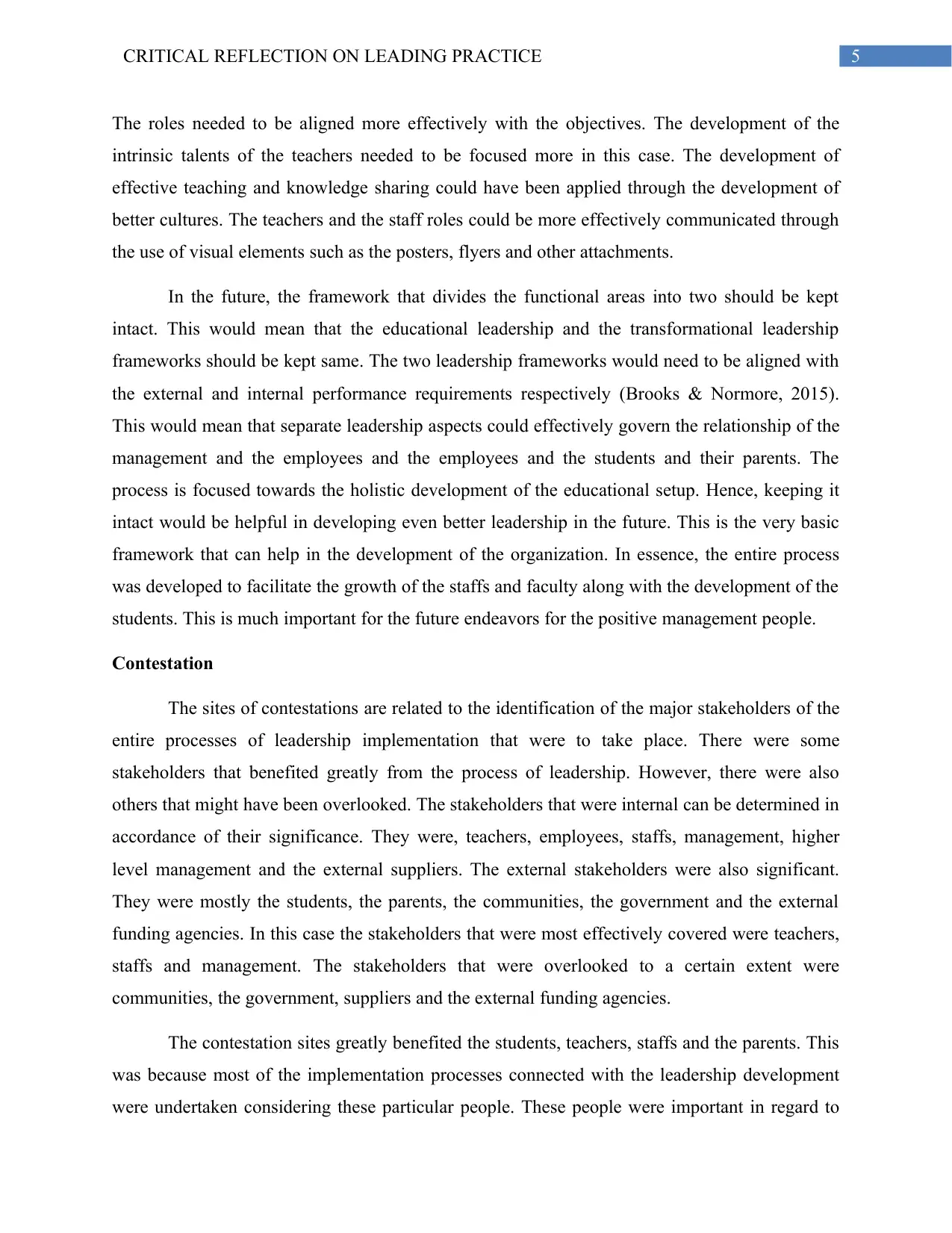
5CRITICAL REFLECTION ON LEADING PRACTICE
The roles needed to be aligned more effectively with the objectives. The development of the
intrinsic talents of the teachers needed to be focused more in this case. The development of
effective teaching and knowledge sharing could have been applied through the development of
better cultures. The teachers and the staff roles could be more effectively communicated through
the use of visual elements such as the posters, flyers and other attachments.
In the future, the framework that divides the functional areas into two should be kept
intact. This would mean that the educational leadership and the transformational leadership
frameworks should be kept same. The two leadership frameworks would need to be aligned with
the external and internal performance requirements respectively (Brooks & Normore, 2015).
This would mean that separate leadership aspects could effectively govern the relationship of the
management and the employees and the employees and the students and their parents. The
process is focused towards the holistic development of the educational setup. Hence, keeping it
intact would be helpful in developing even better leadership in the future. This is the very basic
framework that can help in the development of the organization. In essence, the entire process
was developed to facilitate the growth of the staffs and faculty along with the development of the
students. This is much important for the future endeavors for the positive management people.
Contestation
The sites of contestations are related to the identification of the major stakeholders of the
entire processes of leadership implementation that were to take place. There were some
stakeholders that benefited greatly from the process of leadership. However, there were also
others that might have been overlooked. The stakeholders that were internal can be determined in
accordance of their significance. They were, teachers, employees, staffs, management, higher
level management and the external suppliers. The external stakeholders were also significant.
They were mostly the students, the parents, the communities, the government and the external
funding agencies. In this case the stakeholders that were most effectively covered were teachers,
staffs and management. The stakeholders that were overlooked to a certain extent were
communities, the government, suppliers and the external funding agencies.
The contestation sites greatly benefited the students, teachers, staffs and the parents. This
was because most of the implementation processes connected with the leadership development
were undertaken considering these particular people. These people were important in regard to
The roles needed to be aligned more effectively with the objectives. The development of the
intrinsic talents of the teachers needed to be focused more in this case. The development of
effective teaching and knowledge sharing could have been applied through the development of
better cultures. The teachers and the staff roles could be more effectively communicated through
the use of visual elements such as the posters, flyers and other attachments.
In the future, the framework that divides the functional areas into two should be kept
intact. This would mean that the educational leadership and the transformational leadership
frameworks should be kept same. The two leadership frameworks would need to be aligned with
the external and internal performance requirements respectively (Brooks & Normore, 2015).
This would mean that separate leadership aspects could effectively govern the relationship of the
management and the employees and the employees and the students and their parents. The
process is focused towards the holistic development of the educational setup. Hence, keeping it
intact would be helpful in developing even better leadership in the future. This is the very basic
framework that can help in the development of the organization. In essence, the entire process
was developed to facilitate the growth of the staffs and faculty along with the development of the
students. This is much important for the future endeavors for the positive management people.
Contestation
The sites of contestations are related to the identification of the major stakeholders of the
entire processes of leadership implementation that were to take place. There were some
stakeholders that benefited greatly from the process of leadership. However, there were also
others that might have been overlooked. The stakeholders that were internal can be determined in
accordance of their significance. They were, teachers, employees, staffs, management, higher
level management and the external suppliers. The external stakeholders were also significant.
They were mostly the students, the parents, the communities, the government and the external
funding agencies. In this case the stakeholders that were most effectively covered were teachers,
staffs and management. The stakeholders that were overlooked to a certain extent were
communities, the government, suppliers and the external funding agencies.
The contestation sites greatly benefited the students, teachers, staffs and the parents. This
was because most of the implementation processes connected with the leadership development
were undertaken considering these particular people. These people were important in regard to
⊘ This is a preview!⊘
Do you want full access?
Subscribe today to unlock all pages.

Trusted by 1+ million students worldwide

6CRITICAL REFLECTION ON LEADING PRACTICE
the development of the entire change process. The teachers benefited from the new
developmental and the guidance systems that were formed. The parents were benefitted as they
came into contact with the progress information of their students. The students were greatly
helped as their all-round development was made possible both by the transformational leadership
and the education leadership. There was a significant leadership change that also helped the
staffs to understand their work better.
However, no significant benefit were present in case of the local communities where the
school was located. The communities are important as most of the people related with the school
come from these areas. However, there were no interactive leadership development to engage
with the communities. The government was not benefitted by the leadership process as the
government was not integrated. At the same time there were no significant development for the
suppliers of the resource of the school. There were no steps that were taken to improve the
relationships with the suppliers. There was also the requirement for better engagement with the
external funding agencies that fund the work of the school. The suppliers were ignored to a
significant extent. More engagement with suppliers could have facilitated the holistic
developmental process. More engagement with the funding agencies could have ensured better
financial support to the work of the organization. The diversity improvement functions could
also have been optimized effectively through the engagement of the communities, government,
suppliers and funding agencies. It becomes important in this regards that the plan in the future
integrates more stakeholders in the process of leadership development and implementation.
Implications
The leadership practice that I engaged in as the vice-principal of the school was very
important for my personal and professional development. The leadership practice that was
implemented also helped me to form better methods to improve the standards of the school
organization. It becomes much important that the learnings that were generated from the entire
process are used by me to further improve my professional practice in the future. The better
development of the environment is required. In essence, this leadership endeavor helped me to
develop practices that were important in managing the development process of the school
organization. I was able to develop better ways of interacting with the stakeholders that were the
most important in the entire leadership process. The learning environment that was created was
the development of the entire change process. The teachers benefited from the new
developmental and the guidance systems that were formed. The parents were benefitted as they
came into contact with the progress information of their students. The students were greatly
helped as their all-round development was made possible both by the transformational leadership
and the education leadership. There was a significant leadership change that also helped the
staffs to understand their work better.
However, no significant benefit were present in case of the local communities where the
school was located. The communities are important as most of the people related with the school
come from these areas. However, there were no interactive leadership development to engage
with the communities. The government was not benefitted by the leadership process as the
government was not integrated. At the same time there were no significant development for the
suppliers of the resource of the school. There were no steps that were taken to improve the
relationships with the suppliers. There was also the requirement for better engagement with the
external funding agencies that fund the work of the school. The suppliers were ignored to a
significant extent. More engagement with suppliers could have facilitated the holistic
developmental process. More engagement with the funding agencies could have ensured better
financial support to the work of the organization. The diversity improvement functions could
also have been optimized effectively through the engagement of the communities, government,
suppliers and funding agencies. It becomes important in this regards that the plan in the future
integrates more stakeholders in the process of leadership development and implementation.
Implications
The leadership practice that I engaged in as the vice-principal of the school was very
important for my personal and professional development. The leadership practice that was
implemented also helped me to form better methods to improve the standards of the school
organization. It becomes much important that the learnings that were generated from the entire
process are used by me to further improve my professional practice in the future. The better
development of the environment is required. In essence, this leadership endeavor helped me to
develop practices that were important in managing the development process of the school
organization. I was able to develop better ways of interacting with the stakeholders that were the
most important in the entire leadership process. The learning environment that was created was
Paraphrase This Document
Need a fresh take? Get an instant paraphrase of this document with our AI Paraphraser
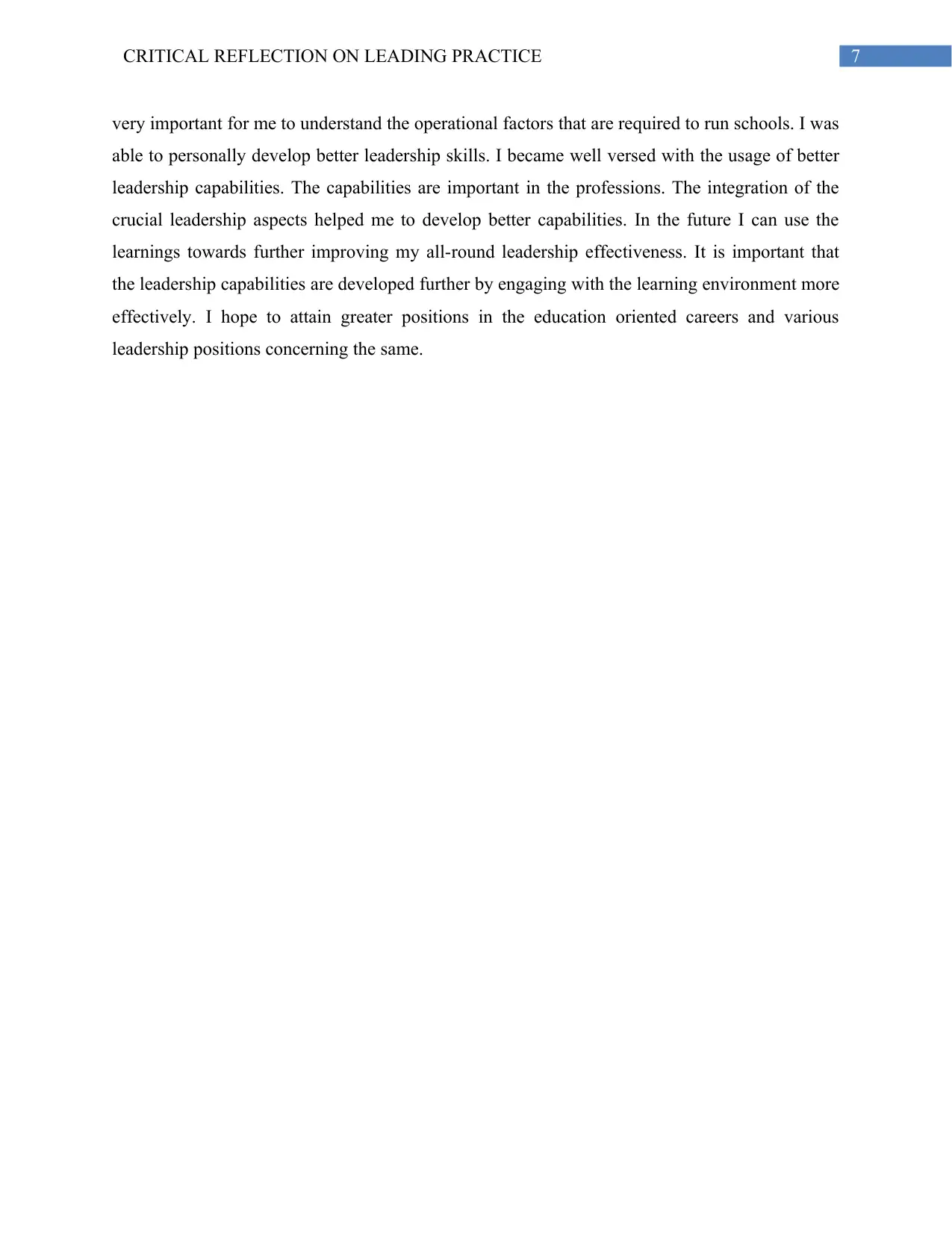
7CRITICAL REFLECTION ON LEADING PRACTICE
very important for me to understand the operational factors that are required to run schools. I was
able to personally develop better leadership skills. I became well versed with the usage of better
leadership capabilities. The capabilities are important in the professions. The integration of the
crucial leadership aspects helped me to develop better capabilities. In the future I can use the
learnings towards further improving my all-round leadership effectiveness. It is important that
the leadership capabilities are developed further by engaging with the learning environment more
effectively. I hope to attain greater positions in the education oriented careers and various
leadership positions concerning the same.
very important for me to understand the operational factors that are required to run schools. I was
able to personally develop better leadership skills. I became well versed with the usage of better
leadership capabilities. The capabilities are important in the professions. The integration of the
crucial leadership aspects helped me to develop better capabilities. In the future I can use the
learnings towards further improving my all-round leadership effectiveness. It is important that
the leadership capabilities are developed further by engaging with the learning environment more
effectively. I hope to attain greater positions in the education oriented careers and various
leadership positions concerning the same.
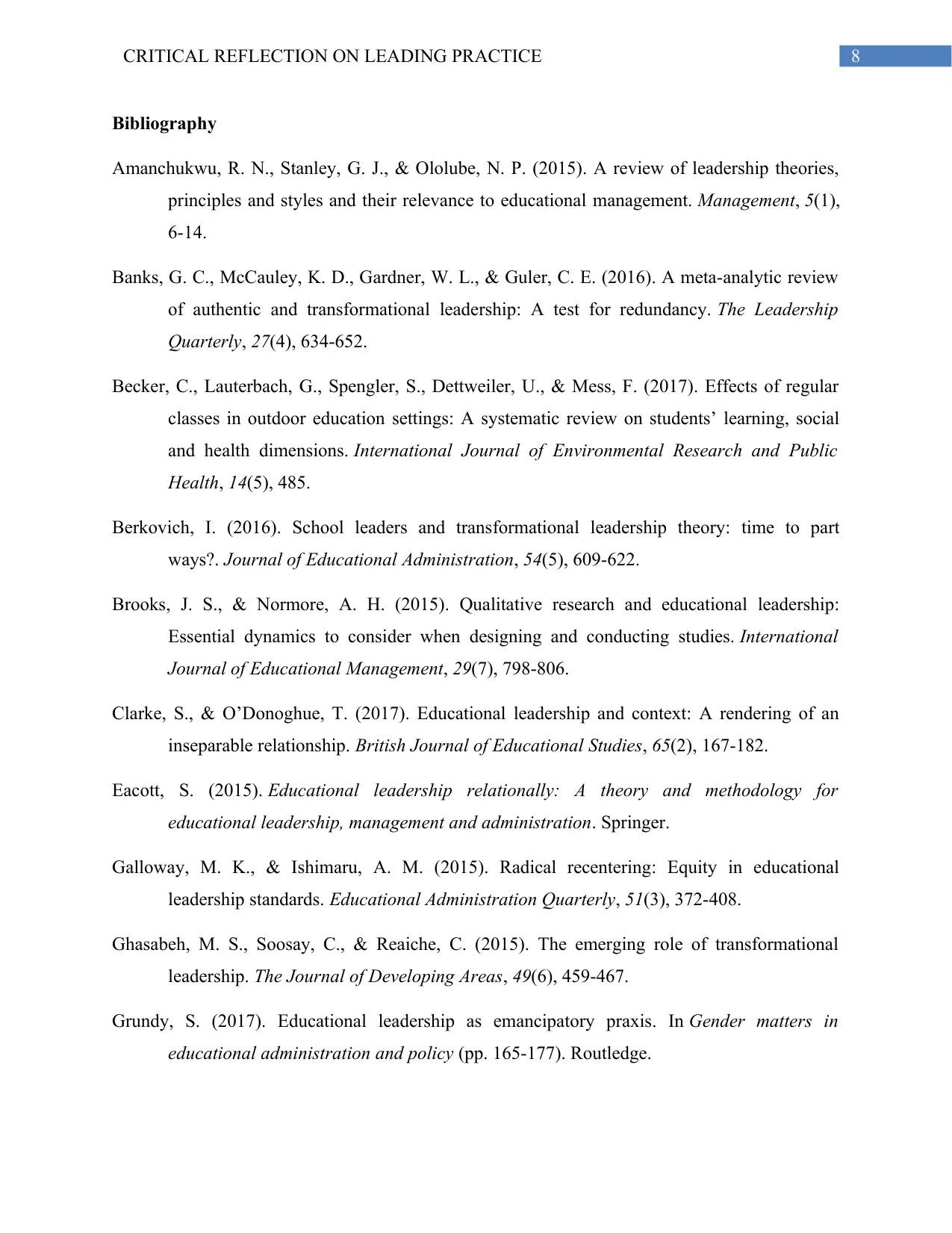
8CRITICAL REFLECTION ON LEADING PRACTICE
Bibliography
Amanchukwu, R. N., Stanley, G. J., & Ololube, N. P. (2015). A review of leadership theories,
principles and styles and their relevance to educational management. Management, 5(1),
6-14.
Banks, G. C., McCauley, K. D., Gardner, W. L., & Guler, C. E. (2016). A meta-analytic review
of authentic and transformational leadership: A test for redundancy. The Leadership
Quarterly, 27(4), 634-652.
Becker, C., Lauterbach, G., Spengler, S., Dettweiler, U., & Mess, F. (2017). Effects of regular
classes in outdoor education settings: A systematic review on students’ learning, social
and health dimensions. International Journal of Environmental Research and Public
Health, 14(5), 485.
Berkovich, I. (2016). School leaders and transformational leadership theory: time to part
ways?. Journal of Educational Administration, 54(5), 609-622.
Brooks, J. S., & Normore, A. H. (2015). Qualitative research and educational leadership:
Essential dynamics to consider when designing and conducting studies. International
Journal of Educational Management, 29(7), 798-806.
Clarke, S., & O’Donoghue, T. (2017). Educational leadership and context: A rendering of an
inseparable relationship. British Journal of Educational Studies, 65(2), 167-182.
Eacott, S. (2015). Educational leadership relationally: A theory and methodology for
educational leadership, management and administration. Springer.
Galloway, M. K., & Ishimaru, A. M. (2015). Radical recentering: Equity in educational
leadership standards. Educational Administration Quarterly, 51(3), 372-408.
Ghasabeh, M. S., Soosay, C., & Reaiche, C. (2015). The emerging role of transformational
leadership. The Journal of Developing Areas, 49(6), 459-467.
Grundy, S. (2017). Educational leadership as emancipatory praxis. In Gender matters in
educational administration and policy (pp. 165-177). Routledge.
Bibliography
Amanchukwu, R. N., Stanley, G. J., & Ololube, N. P. (2015). A review of leadership theories,
principles and styles and their relevance to educational management. Management, 5(1),
6-14.
Banks, G. C., McCauley, K. D., Gardner, W. L., & Guler, C. E. (2016). A meta-analytic review
of authentic and transformational leadership: A test for redundancy. The Leadership
Quarterly, 27(4), 634-652.
Becker, C., Lauterbach, G., Spengler, S., Dettweiler, U., & Mess, F. (2017). Effects of regular
classes in outdoor education settings: A systematic review on students’ learning, social
and health dimensions. International Journal of Environmental Research and Public
Health, 14(5), 485.
Berkovich, I. (2016). School leaders and transformational leadership theory: time to part
ways?. Journal of Educational Administration, 54(5), 609-622.
Brooks, J. S., & Normore, A. H. (2015). Qualitative research and educational leadership:
Essential dynamics to consider when designing and conducting studies. International
Journal of Educational Management, 29(7), 798-806.
Clarke, S., & O’Donoghue, T. (2017). Educational leadership and context: A rendering of an
inseparable relationship. British Journal of Educational Studies, 65(2), 167-182.
Eacott, S. (2015). Educational leadership relationally: A theory and methodology for
educational leadership, management and administration. Springer.
Galloway, M. K., & Ishimaru, A. M. (2015). Radical recentering: Equity in educational
leadership standards. Educational Administration Quarterly, 51(3), 372-408.
Ghasabeh, M. S., Soosay, C., & Reaiche, C. (2015). The emerging role of transformational
leadership. The Journal of Developing Areas, 49(6), 459-467.
Grundy, S. (2017). Educational leadership as emancipatory praxis. In Gender matters in
educational administration and policy (pp. 165-177). Routledge.
⊘ This is a preview!⊘
Do you want full access?
Subscribe today to unlock all pages.

Trusted by 1+ million students worldwide
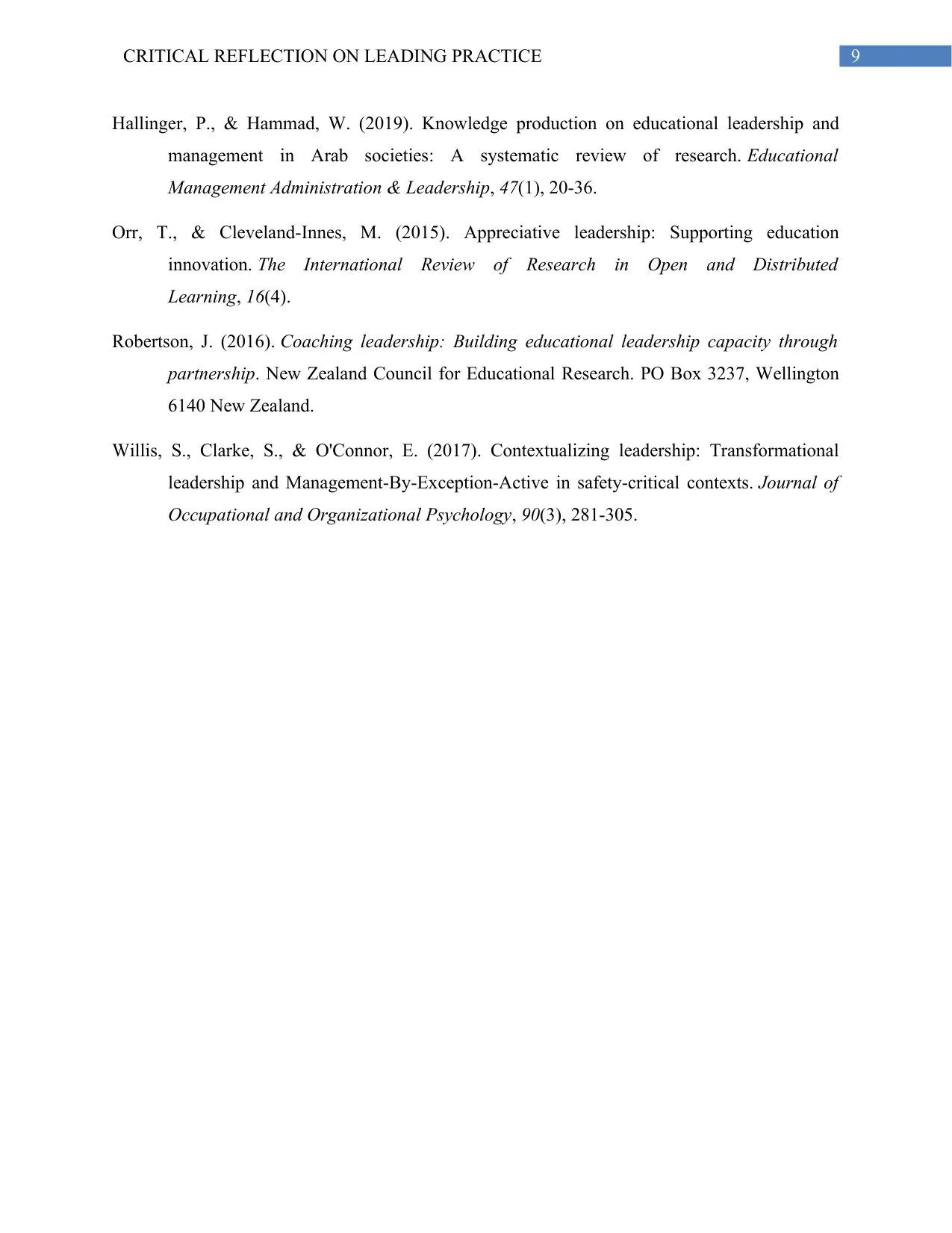
9CRITICAL REFLECTION ON LEADING PRACTICE
Hallinger, P., & Hammad, W. (2019). Knowledge production on educational leadership and
management in Arab societies: A systematic review of research. Educational
Management Administration & Leadership, 47(1), 20-36.
Orr, T., & Cleveland-Innes, M. (2015). Appreciative leadership: Supporting education
innovation. The International Review of Research in Open and Distributed
Learning, 16(4).
Robertson, J. (2016). Coaching leadership: Building educational leadership capacity through
partnership. New Zealand Council for Educational Research. PO Box 3237, Wellington
6140 New Zealand.
Willis, S., Clarke, S., & O'Connor, E. (2017). Contextualizing leadership: Transformational
leadership and Management‐By‐Exception‐Active in safety‐critical contexts. Journal of
Occupational and Organizational Psychology, 90(3), 281-305.
Hallinger, P., & Hammad, W. (2019). Knowledge production on educational leadership and
management in Arab societies: A systematic review of research. Educational
Management Administration & Leadership, 47(1), 20-36.
Orr, T., & Cleveland-Innes, M. (2015). Appreciative leadership: Supporting education
innovation. The International Review of Research in Open and Distributed
Learning, 16(4).
Robertson, J. (2016). Coaching leadership: Building educational leadership capacity through
partnership. New Zealand Council for Educational Research. PO Box 3237, Wellington
6140 New Zealand.
Willis, S., Clarke, S., & O'Connor, E. (2017). Contextualizing leadership: Transformational
leadership and Management‐By‐Exception‐Active in safety‐critical contexts. Journal of
Occupational and Organizational Psychology, 90(3), 281-305.
1 out of 10
Related Documents
Your All-in-One AI-Powered Toolkit for Academic Success.
+13062052269
info@desklib.com
Available 24*7 on WhatsApp / Email
![[object Object]](/_next/static/media/star-bottom.7253800d.svg)
Unlock your academic potential
Copyright © 2020–2025 A2Z Services. All Rights Reserved. Developed and managed by ZUCOL.





